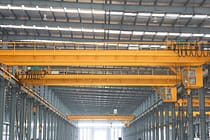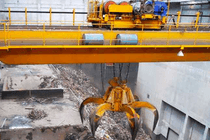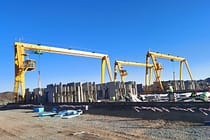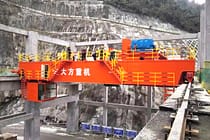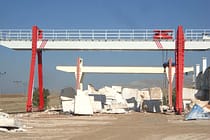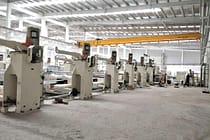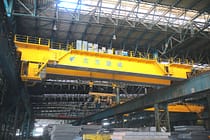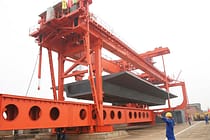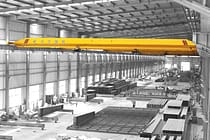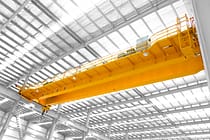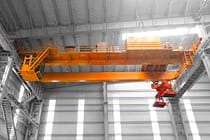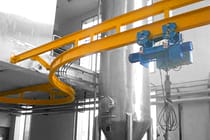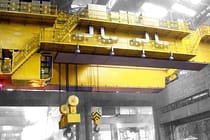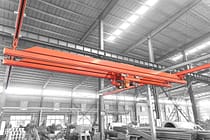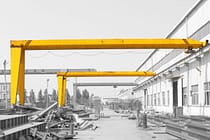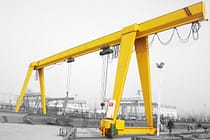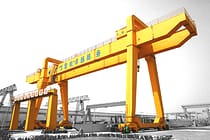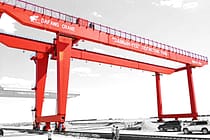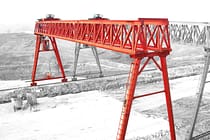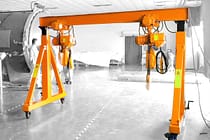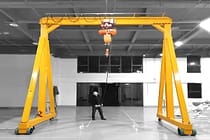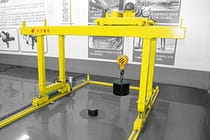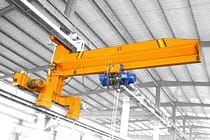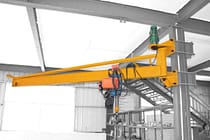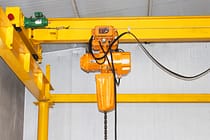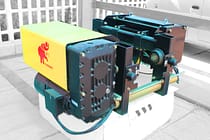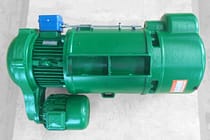Inspektion metallurgischer Brückenkräne: Wichtige Punkte zur Gewährleistung von Sicherheit und Betriebsstabilität
Inhaltsverzeichnis
Der Artikel ist im Wesentlichen in vier Abschnitte gegliedert. Zunächst werden die Prüfmethoden für metallurgische Brückenkräne erläutert, anschließend werden häufige Probleme dieser Kräne zusammengefasst und anschließend spezifische Prüfschwerpunkte und wichtige Vorsichtsmaßnahmen erläutert. Ziel ist es, den sicheren und stabilen Betrieb von Brückenkränen zu gewährleisten, um den Anforderungen der metallurgischen Produktion gerecht zu werden.
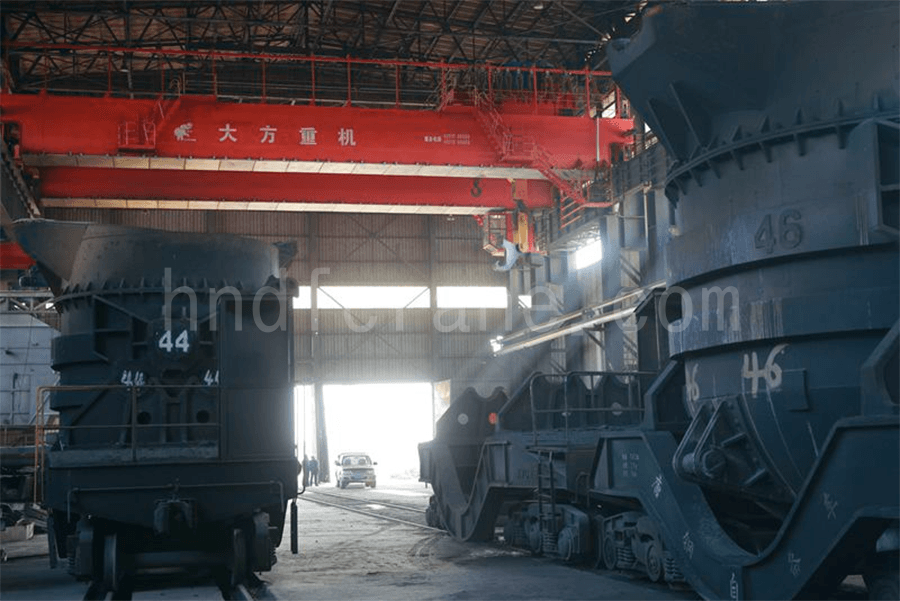
Gängige Inspektionsmethoden für metallurgische Brückenkräne
Zu den gängigen Prüfmethoden für metallurgische Brückenkräne gehören die Nivelliermethode, die Totalstationsmethode und die Stahldrahtspannmethode. Nachfolgend finden Sie eine detaillierte Analyse und Erläuterung dieser Methoden:
Nivellierinstrumentenmethode
Die Nivelliermethode ist eine der am häufigsten verwendeten Techniken bei der Inspektion von metallurgischen Brückenkränen. Sie ist relativ einfach anzuwenden und umfasst im Wesentlichen zwei Ansätze: die Höhenmessung und die Seilmethode.
- Höhenmessung: Bei dieser Methode wird ein Nivelliergerät im metallurgischen Produktionsbereich positioniert und eine Messlatte auf die Schienendruckplatte gelegt, wodurch ein leichter Versatz entsteht. Mithilfe des Nivelliergeräts werden dann verschiedene Daten gemessen und präzise aufgezeichnet.
- Seilmethode: Bei dieser Methode werden ein Stahlseil und eine Messlatte unter dem Seil aufgehängt, während das Nivelliergerät auf einer ebenen Fläche aufgestellt wird. Durch Vergleich und Analyse der Messdaten können potenzielle Probleme im Kransystem identifiziert werden.
Totalstationsinspektion
Die Totalstationsmethode misst effektiv Vertikalität und Höhenunterschiede. Im Vergleich zu herkömmlichen Methoden nutzt sie elektronische Messwerte und ermöglicht die automatische Aufzeichnung und Anzeige von Inspektionsdaten, was eine höhere Genauigkeit gewährleistet. Sobald die Totalstation installiert ist, kann sie bei der Kraninspektion die vollständige Parameterprüfung des Brückenkrans durchführen und so Effizienz und Sicherheit verbessern.
Methode mit gespanntem Stahldraht
Zur Messung der Überhöhung wird vorwiegend die Methode mit gespanntem Stahldraht verwendet. Ein spezielles Stahldrahtseil wird mit einem Ende am Endträger des metallurgischen Brückenkrans befestigt. Ein Gewicht wird auf die obere Abdeckplatte gelegt, um den Draht zu spannen, während das andere Ende mithilfe einer 150-N-Federwaage gespannt wird. Durch Auswahl geeigneter Messpunkte wird der vertikale Abstand vom Draht zur Oberseite des Hauptträgers in Spannweitenmitte gemessen. Anschließend wird die Überhöhung präzise berechnet, um anhand der Ergebnisse festzustellen, ob strukturelle oder Ausrichtungsprobleme am Kran vorliegen.
Häufige Probleme bei metallurgischen Brückenkränen
Im Betrieb von metallurgischen Brückenkränen treten zwangsläufig bestimmte Probleme auf, die ihre Sicherheit und Betriebseffizienz erheblich beeinträchtigen und letztlich zu einer verringerten Produktionsleistung führen können. Zu den häufigsten Problemen zählen:
Schienennagen
Schienenverschleiß ist ein häufiges Problem bei metallurgischen Brückenkränen. Typischerweise ist die Breite der Kran- und Laufkatzenräder größer als die Spurweite, wodurch ein deutlicher Abstand zwischen Spurkränzen und Schienen entsteht. Bei mangelhafter Kranfertigung oder unsachgemäßer Montage können die Räder während des Betriebs nicht korrekt mit der Schienenmitte ausgerichtet bleiben. Stattdessen können sie seitlich an der Schiene anliegen, was zu starkem Verschleiß führt. Mit der Zeit verformt sich der Spurkranz und führt zum Schienenverschleiß, was die Betriebsstabilität des Krans beeinträchtigt und den Wartungsaufwand erhöht.
Elektrische Fehler
Elektrische Fehler sind ein zentrales Problem bei der Inspektion metallurgischer Brückenkräne. Zu den Hauptursachen solcher Fehler zählen:
- Schlechter Hauptstromkreiskontakt: Der Hauptstromkreis ist ein wesentlicher Bestandteil eines metallurgischen Brückenkrans und funktioniert ähnlich wie ein Hauptluftschalter. Er spielt eine entscheidende Rolle bei der Überwachung des elektrischen Zustands des Systems und der Identifizierung potenzieller Probleme. Wenn jedoch bei elektrischen Inspektionen die Sammelschiene nicht installiert ist oder einen schlechten Kontakt aufweist, kann ein auftretender Fehler möglicherweise nicht rechtzeitig eine Stromabschaltung auslösen, was schwerwiegende Folgen haben kann.
- Verschleiß des Kabelmantels: Aufgrund der komplexen Umgebung der metallurgischen Produktion sind Brückenkräne während des Betriebs häufig externen Einflüssen ausgesetzt, die die Qualität und Lebensdauer der Anlage beeinträchtigen können. Insbesondere Kabelmäntel unterliegen Verschleiß und Alterung, was sich negativ auf die Betriebsstabilität und Sicherheit des Krans auswirkt. Entgleist das Kabel von seiner vorgesehenen Bahn, kann es sogar gequetscht werden, was zu Kabelschäden und erhöhten Sicherheitsrisiken führt.
- Unsachgemäße Betriebspraktiken: Wenn Bediener beim Kranbetrieb die Standardverfahren nicht einhalten, routinemäßige Wartungen oder Inspektionen vernachlässigen oder das Sicherheitsbewusstsein des Personals unzureichend ist, können zahlreiche Sicherheitsrisiken entstehen. Dies gefährdet nicht nur den sicheren Kranbetrieb, sondern beeinträchtigt auch die Produktionszuverlässigkeit.
Unsachgemäße Installation
Der Betriebszustand eines metallurgischen Brückenkrans hängt eng mit seiner Verarbeitungsqualität zusammen, insbesondere mit der Installation. Eine unsachgemäße Installation kann die Stabilität des Krans erheblich beeinträchtigen. In schweren Fällen kann dies zu Unfällen mit finanziellen Verlusten oder sogar Verletzungen führen. Zu den häufigsten Installationsproblemen gehören:
- Fundament entspricht nicht den tatsächlichen Bedingungen: Wenn das Kranfundament nicht den Anforderungen des Produktionsstandorts entspricht, wird der Betrieb metallurgischer Anlagen erschwert. Mangelndes Sicherheitsbewusstsein oder mangelnde Beherrschung der Montageverfahren durch die Arbeiter können zu Abweichungen von den Standardverfahren führen, was die Kranleistung beeinträchtigt.
- Unzureichender Abstand zu stromführenden Leitungen: Gemäß den Betriebssicherheitsnormen dürfen metallurgische Brückenkräne während des Betriebs nicht mit stromführenden Leitungen in Berührung kommen. Werden keine ausreichenden Sicherheitsabstände zwischen beweglichen Teilen und Stromleitungen eingehalten, erhöht sich das Risiko elektrischer Gefahren und Geräteausfälle.
- Fehlende oder unsachgemäß installierte Sicherheitseinrichtungen: Wird beim Kranaufbau kein Lastbegrenzer installiert, kann der Kran nicht innerhalb der sicheren Lastgrenzen arbeiten, was ein erhebliches Sicherheitsrisiko darstellt. Darüber hinaus kann es bei unsachgemäß installierten Schutzeinrichtungen dazu kommen, dass die Notabschaltung im Fehlerfall nicht ordnungsgemäß funktioniert. Dies kann zu Betriebsunterbrechungen und potenzieller Gefährdung des Personals führen.
Wichtige Inspektionspunkte für metallurgische Brückenkräne
Mechanische Inspektion
- Der Hauptträger muss nivelliert werden. Der Höhenunterschied zwischen den Endlagerplatten darf maximal 2 mm betragen. Bei einer Zweiträgerkonstruktion sollte der Unterlegrahmen unterhalb der Träger platziert werden. Bei einer Einträgerkonstruktion sollte die Mitte der Unterlegstütze 700 mm von der Plattenaußenseite entfernt positioniert sein. Bei der Inspektion ist die genaue Platzierung des Nivellierinstruments unbedingt sicherzustellen. Die Messlatte sollte präzise auf der Deckplatte platziert werden, versetzt zur Hauptstegplatte und getrennt von der Schienenandruckplatte.
- Messen Sie mit dem Nivelliergerät und berechnen Sie den Durchschnittswert anhand der Prüfdaten. Platzieren Sie Messlatten an geeigneten Stellen auf den Deckplatten der drei Zwischenmembranen. Achten Sie darauf, dass sie von der Hauptstegplatte versetzt sind und die Schienenpressplatten nicht berühren. Bestimmen Sie gleichzeitig die Wölbung anhand der tatsächlichen Bedingungen und nutzen Sie die Messdaten, um Probleme zu erkennen und rechtzeitig zu beheben.
Inspektion der elektrischen Anlage
- Die Nullstellungssicherung im elektrischen System des metallurgischen Brückenkrans muss überprüft werden, um sicherzustellen, dass während des Betriebs die Stromversorgung des Systems nicht plötzlich unterbrochen wird, wenn sich der Steuergriff an der Bedienkonsole nicht in der Nullstellung befindet. Befindet sich der Bediener nicht an der Konsole und bringt den Griff nicht in die Nullstellung zurück, kann das Einschalten zu einem Unfall führen. Daher spielt die Nullstellungssicherung eine wichtige Rolle. Eine ordnungsgemäße Überprüfung in diesem Bereich kann dazu beitragen, Sicherheitsvorfälle zu vermeiden.
- Während des Betriebs des metallurgischen Brückenkrans kann die Steuerung das elektrische System streng kontrollieren. Sollte das System jedoch nicht automatisch zurückgesetzt werden können, sollte eine den tatsächlichen Bedingungen entsprechende Schutzeinrichtung installiert werden, um Unfälle zu vermeiden. Wird die automatische Rücksetzung unterstützt, ist die Schutzeinrichtung möglicherweise nicht erforderlich. Zusätzlich kann mit dem Einschalttest geprüft werden, ob das elektrische System des Krans Fehler aufweist.
- Auch die Überprüfung des Erdungswiderstandes ist eine wichtige Aufgabe. Die Schutz- und Wiederholungserdung muss sinnvoll und fachgerecht ausgeführt sein, um eine zuverlässige Stromleitung zu gewährleisten.
Inspektion des Installationsprozesses
Die Sicherstellung der Qualität des Installationsprozesses ist entscheidend für die Verbesserung der Stabilität und Sicherheit des metallurgischen Brückenkranbetriebs. Bei der Überprüfung der Installationsverfahren ist auf folgende Punkte zu achten:
- Entsprechend den Eigenschaften des metallurgischen Brückenkrans ist eine stabile und zuverlässige Installationsmethode erforderlich. Der Kran sollte für die Installation flach auf dem Boden stehen, um Stabilität und Sicherheit zu gewährleisten. Zusätzlich kann ein Lastbegrenzer in der Kranstruktur installiert werden, um die Sicherheit zu erhöhen. Sobald der Kran die Nennlast überschreitet, schaltet das Gerät automatisch die Stromzufuhr ab, um das Unfallrisiko zu verringern.
- Die Installation sollte entsprechend den tatsächlichen Bedingungen und Anforderungen des metallurgischen Produktionsbereichs erfolgen, um einen reibungslosen Installationsprozess zu gewährleisten. Achten Sie auch auf unebene oder geneigte Böden in der Produktionsumgebung und verbessern Sie die Installationstechniken entsprechend. Achten Sie bei der Installation auf die Tragfähigkeit der Anlage und stellen Sie sicher, dass Verkabelung und Erdung ordnungsgemäß ausgeführt sind. Führen Sie eine gründliche Inspektion durch, um sicherzustellen, dass die Tragfähigkeit des Krans den relevanten Anforderungen entspricht, und beugen Sie so effektiv Sicherheitsunfällen vor.
- Um das Problem des Schienenfressens bei metallurgischen Brückenkränen zu lösen, müssen Installationsabweichungen streng kontrolliert und innerhalb eines akzeptablen Rahmens gehalten werden. Bei der Installation ist darauf zu achten, dass die Räder waagerecht und mittig und vertikal auf den Schienen ausgerichtet sind. Stellen Sie außerdem sicher, dass Motordrehzahl und -leistung übereinstimmen, um den normalen Betrieb des metallurgischen Brückenkrans zu gewährleisten.
Inspektionsüberlegungen für metallurgische Brückenkräne
- Sicherheit hat höchste Priorität: Gemäß den geltenden Normen und Vorschriften sollte Sicherheit oberste Priorität haben. Um die Sicherheit metallurgischer Brückenkräne umfassend zu verbessern, muss ein Schwerpunkt auf Sicherheitsinspektionen gelegt werden.
- Kritische Komponenten gründlich prüfen: Inspektionsarbeiten müssen sorgfältig durchgeführt werden, wobei den wichtigsten und kritischen Teilen besondere Aufmerksamkeit zu schenken ist. Zeitpunkt und Häufigkeit der Inspektionen sollten sorgfältig geplant werden. Beispielsweise erfordern Mechanismen wie Fahr- und Wippsysteme detailliertere Inspektionen, die je nach tatsächlichen Bedingungen wiederholt durchgeführt werden sollten, um Sicherheitsrisiken umgehend zu beseitigen und den sicheren Betrieb der Anlage zu gewährleisten.
- Verbesserung der Fachkompetenz der Inspektoren: Um die Effektivität der Inspektionen zu gewährleisten, sollten die Fachkenntnisse des Inspektionspersonals verbessert werden. Dies kann durch umfassende Bewertungen unter Berücksichtigung von Erscheinungsbild, Leistung und Sicherheitsaspekten erreicht werden, wodurch das technische Niveau der Inspektoren kontinuierlich gestärkt wird. Darüber hinaus sollten alle bei Inspektionen festgestellten Probleme umgehend behoben und ausführliche Aufzeichnungen mit den Ursachen und Orten der Probleme geführt werden, um eine Grundlage für zukünftige Wartungsarbeiten zu schaffen.
Abschluss
Brückenkräne sind in der metallurgischen Produktion weit verbreitet und tragen maßgeblich zur Verbesserung der Betriebseffizienz bei. Aufgrund der komplexen Struktur metallurgischer Brückenkräne müssen Inspektionsarbeiten jedoch ernst genommen werden. Durch regelmäßige Inspektionen zur rechtzeitigen Erkennung häufiger Probleme und die Umsetzung gezielter Lösungen kann der sichere und stabile Betrieb der Anlagen gewährleistet werden. Dies trägt dazu bei, potenzielle Sicherheitsrisiken zu eliminieren oder zu reduzieren und den reibungslosen Ablauf der metallurgischen Produktion zu unterstützen.
Referenz: Wichtige Inspektionspunkte für metallurgische Brückenkräne
Senden Sie Ihre Anfrage
- Email: sales@hndfcrane.com
- WhatsApp: +86 191 3738 6654
- Telegramm: +86 191 3738 6654
- Tel: +86-373-581 8299
- Fax: +86-373-215 7000
- Hinzufügen: Industriegebiet Changnao, Stadt Xinxiang, Provinz Henan, China
 WeChat
WeChat
